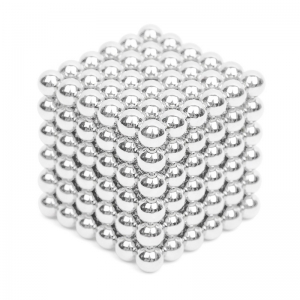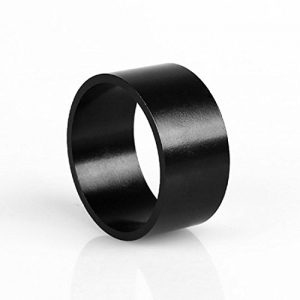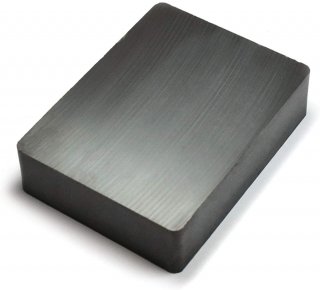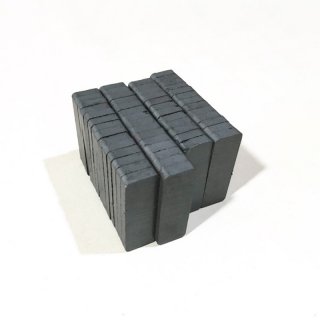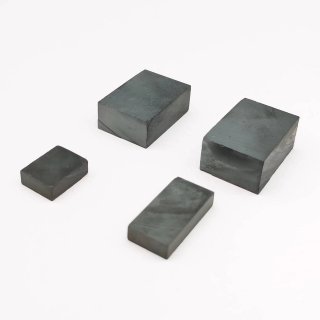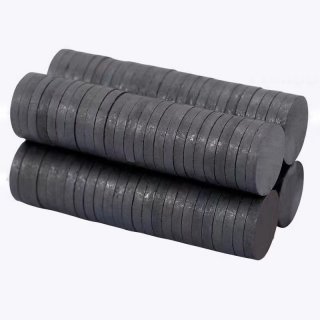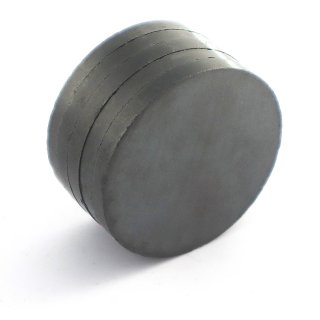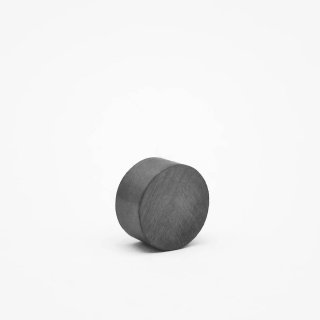Ceramic magnets or ferrite magnets are sintered permanent magnets composed of barium or strontium carbonate, and iron oxide. This class of magnets, aside from good resistance to demagnetization, has the popular advantage of low cost. The sorts of hard ferrite magnets are manifold and complete. They are charcoal gray in color and usually appear in the forms of toroid, circular disk, square, bar, arc segment, blocks, rings, cylinders special magnets etc. The detail specifications are up to hundreds of kinds.
The corrosion resistance of Ferrite is considered excellent and no surface treatments are required. It can be used in temperatures up to 80 degrees C. However, Ceramic magnets may have a thin film of fine magnet powder on the surface and for clean, non-contaminated applications, some form of coating may be required. Standard parts include blocks, discs, rings & round bars in different dimensional specifications. Magnets are available in different shapes & sizes and can also be custom fabricated according to specifications & tolerances.
Ferrite magnets are very hard and brittle, and require specialized machining techniques. Moreover, they should be machined in an unmagnetized state. We are equipped to machine these materials to specifications. Anisotropic grades are oriented in the manufacturing direction, and must be magnetized in the direction of orientation. Isotropic grades are not oriented and can be magnetized in any direction, although some degree of greater magnetic strength will be found in the pressing dimension, usually the shortest dimension.
Anisotropic wet ferrite matgnets are oriented in the manufacturing direction, and must be magnetized in the direction of orientation. Isotropic dry ferrite magnets are not oriented and can be magnetized in any direction, although some degree of greater magnetic strength will be found in the pressing dimension, usually the shortest dimension.Due to their low cost, Ceramic magnets enjoy a very wide range of applications, from motors and loudspeakers to toys and crafts, and are the most widely used permanent magnets today.Our main products includes: Hard ferrite arc or segment magnet, ring magnets, rectangular magnets, ferrite podwer etc. Which have the following advantages: high coercive force, high electric resistance, long-time stability, and economical price. Meanwhile, AOMag can manufacture new tools according to the customers` demand. Recent years, we have been placing the emphasis on producing the high property magnets for the motors of automobiles and motorcycles. The characteristics of the products have kept in the leading level in China.
Ceramic magnets China Manufacturing Methods
1.Pressing and Sintering:Pressing and sintering involves pressing very fine ferrite powder in a die, and then sintering this pressed magnet. All fully dense Ferrite magnets are produced this way. It can be wet pressed or dry pressed ferrite magnets. Wet pressing Ceramic magents yields better magnetic properties, but poorer physical tolerances. Generally, the powder is dry for grade 1 or 5 materials, and wet for grade 8 and higher materials. Sintering involves subjecting the material to high temperatures to fuse the pressed powder together, thus creating a solid material. Magnets produced through this process usually need to have some finish machining, otherwise surface finishes and tolerances are not acceptable. Some manufacturers extrude instead of press wet powder slurry and then sinter the material. This is sometimes done for arc segment shapes, where the arc cross-section is extruded in long lengths, sintered, and then cut to length.
2.Injection Molding: Ferrite powder is mixed into a compound and then injection molded in the same way as plastic.Tooling for this manufacturing process is usually very costly. However, parts produced through this process can have very intricate shapes and tight tolerances. Injection molded ferrite properties are either lower or about the same as grade 1 Ferrite.
3.Assemblies: AOMag are able to manufacture metal and other components of finished sub assemblies using our CNC machining facilities.Assemblies using metal or other components and magnets can be fabricated by adhering magnets with adhesives to suit a range of environments, by mechanically fastening magnets, or by a combination of these methods. Due to the relatively brittle nature of these magnet materials, press fits are not recommended.
4.Surface Treatments: The corrosion resistance of Ferrite is considered excellent , and no surface treatments are required. However, Ferrite magnets may have a thin film of fine magnet powder on the surface and for clean, non-contaminated applications, some form of coating may be required.
5.Machining: Ferrite is brittle, and prone to chipping and cracking. Special machining techniques must be used to machine this material. We are fully equipped to machine these materials to your blueprint specifications.
6.Magnetizing and Handling: Ceramic magnets require magnetizing fields of about 10 kOe. They can be magnetized with multiple poles on one or both pole surfaces. No special handling precautions are required, except that large blocks of Ferrite magnets are powerful, and care should be taken to ensure that they do not snap towards each other.
7.Temperature Effects: Up to about 840F, changes in magnetization are largely reversible, while changes between 840F and 1800 F are re-magnetizable. For all Ceramic magnets, the degradation of magnetic properties is essentially linear with temperature. At 350 F, about 75% of room temperature magnetization is retained, and at 550 F, about 50% is retained.
8.Common Applications for Ferrite Magnets: Ceramic magnets are widely used in motors, magnetic couplings, for sensing, loudspeakers, holding-magnet systems, crafts, magnetic therapy, novelties, and toys.







